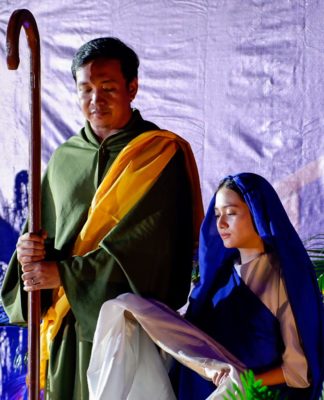 YEAR after year, waves of Marian devotees visit the Santo Domingo Church in Quezon City in early October, to get a glimpse of Our Lady of the Holy Rosary, La Naval de Manila.
YEAR after year, waves of Marian devotees visit the Santo Domingo Church in Quezon City in early October, to get a glimpse of Our Lady of the Holy Rosary, La Naval de Manila.
Last October 10, thousands of Marian followers gathered to renew their lives and faith, as the Catholic Church once again observed in silence and joy the most celebrated Marian image in the country.
Nuestra Señora de la Naval’s exquisite frock and oriental features have become a definitive characteristic of all the Marian images styled “Queen of the Rosary”.
The Feast of Our Lady of La Naval has long been attracting devout Catholics all over the country. Through her ardent devotees, her feast has become the most attended Marian celebration in the country.
During the annual procession, Marian devotees would solemnly walk alongside the image while carrying candles and reciting the rosary.
This age-old tradition of Filipinos dates back four centuries ago. The festivity reflects the devotion of the Catholics to the Virgin Mary and her strong bond with the Filipino culture.
This year’s theme was La Naval: Tagumpay sa Pagbabagong-buhay.
Sto. Domingo Convent prior Fr. Giuseppe Pietro Arsciwals, O.P. said in his homily last September 30 that the outcome of the recent election was prompted by the people’s clamor for change.
“The true change can come from the person who accepts the will of God for him or her. This is the triumph of the Blessed Virgin,” Arsciwals said in a report from CBCPNews.com.
Novena masses were held in honor of the feast of La Naval at the Sto. Domingo Church along Quezon Avenue (National Shrine of Our Lady of the Holy Rosary) from October 1 to October 10.
The celebration, organized by the Dominican Province of the Philippines, began last September 30 with the Solemn Rite of Enthronement of the image of La Naval at the main altar of her shrine at the Sto. Domingo Church in Quezon City.
During the novena masses, priests hailed Mary whose “beauty is incomparable” and praised her miraculous contributions.
In his homily last October 7, Bishop Teodoro Bacani said that the beauty of the Virgin Mary is incomparable, a gift from God unblemished of any sins.
“Ang ganda ni Maria ay walang kupas, biyaya ng Diyos,” said Bacani. “Dapat ay maitulad tayo sa kaniyang gandang walang bahid ng masama.”
On the same day, the image was brought down from the altar to let the devotees touch and kiss any part of the clothing of the image and ask for her blessings. The practice is called the Beso Manto.
“Hinihikayat tayo ni Maria na magbagong-buhay. Ang pagbabagong ito ay hindi radical, kundi magrecover mula sa ating mga sarili,” said UST Rector Fr. Rolando dela Rosa O.P. in his homily last October 8.
On the feast day last October 10, a grand La Naval procession was held to pay tribute to the Marian image’s contributions to the country and her divine interventions. The image was followed by a pantheon of exquisitely garbed Dominican saints, including the icons of St. Thomas Aquinas and St. Martin de Porres. Afterwards, the image was brought back to the pedestal.
The entire celebration was carried out in Filipino instead of the usual English.
Unblemished history
Robed with a gold cape embellished with silver threads, the fifty-six-inch tall image has withstood the test of time, enduring many trials and tribulations in its almost 400 years of existence.
The sculpture of Our Lady of the Rosary was commissioned in 1954 at the request of then acting Governor General of the Philippines Don Luis Dasmariñas to honor his deceased father and his own regime.
Under the direction of Captain Hernando de los Rios Coronel, a Chinese artist sculpted the statue with its head and hands made of ivory. The Chinese later became a Catholic convert.
The image was housed at the side altars of Sto. Domingo Church in Intramuros for more than a century.
In March 1646, 15 Dutch ships breached the Philippine territory and attacked the country. This is famously known as the Battle of La Naval, a string of five naval combats between the Spanish and Filipino defenders and the Dutch invaders.
The Filipinos, being devout Catholics, prayed to the Lady of the Rosary, the famous devotion promoted by the Dominicans, for help.
Two galleons, “The Rosary” and “The Incarnation,” which served as merchant ships, fought the enemies. With the help of the image, they won the battle against the Dutch.
During the Second World War, Sto. Domingo Church in Intramuros was razed. But miraculously, the Lady of the Rosary was spared from devastation.
Following the catastrophe, UST provided the image shelter from 1942 to 1954.
La Naval was the first Marian image to be canonically crowned in Asia on October 5, 1907.
In 1981, Pope John Paul II dedicated the Philippines to Mary, Queen of the Rosary under the title of La Naval.
Enduring the catastrophe at her previous shrine in Intramuros was just half the battle, as she experienced another tragedy at the University. The UST Chapel (now Santisimo Rosario Parish), where the image was sheltered, was bombed by enemies. Luckily, the bomb fell just a few inches from the image and left La Naval unscathed.
In 1956, its last year at the University, the image was transferred to her new and permanent shrine at the Sto. Domingo Church in Quezon City.
In the same year— a Marian Year—the new shrine was declared the “National Shrine of Our Lady of the Rosary” by the Philippine Hierarchy.














naiyak ako sa article mo. super ganda niya. I wish La Naval is an all year round activity. thank you po sa article niyo!